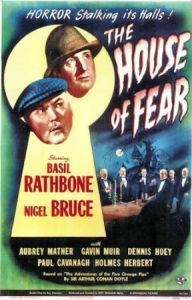 DEATH STALKS ITS HALLS! Horror seeps from its walls!
DEATH STALKS ITS HALLS! Horror seeps from its walls!
The House of Fear(1945) is the tenth in the series of fourteen Sherlock Holmes films starring Basil Rathbone and Nigel Bruce. The first two (1939) are from 20th Century-Fox, a first-class studio which, while most movies and plays had updated the Sir Arthur Conan Doyle stories to the present, wisely chose to return the plots to their original turn-of-the-twentieth-century settings, with gaslight and hansoms. The time period is not entirely “Victorian” England as many suppose, since about half of Doyle’s writings, including the novel The Hound of the Baskervilles, were published after Queen Victoria’s death in 1901.
The last twelve of these Rathbone films are from one of the smaller studios, Universal, which, especially, in the first three movies, sought to move Holmes even further forward, to the exact present, which then was World War II, and send the detective sniffing after Nazis. Now, with spies, ciphers, propaganda broadcasts, microfilm and bombs, these adventures became espionage thrillers, not true detective stories.
The studio made a dramatic about-face with the fourth film, Sherlock Holmes Faces Death, a return, if not in time then in atmosphere, to gloomy old houses and the art of Holmesian deduction. With only one lapse—in The Spider Woman (1944), where an image of Hitler is used as a target in a shooting gallery amusement park—the remaining Universal films were more faithful in ambiance and script, though their quality steadily declined. The last, Dressed to Kill, and four films after The House of Fear, would close the series in 1946, though the most ineffectual isPursuit to Algiers, the third to last.
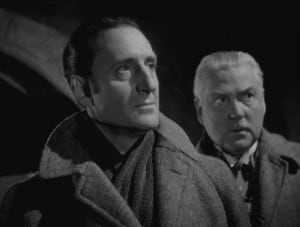 Coming about two-thirds into the Universal set, The House of Fear could mark, depending upon your viewpoint and familiarity with these films, a crucial place in the chain. One critic proclaimed the movie as “the last fully satisfying entry in the series.” Another saw it as “disappointing, lacking in interest, slow-moving and dull.” Even the former source hedged on the praise by adding, “It was time to put more dash into the series.” So which is it, “fully satisfying” or in need of “more dash”?
Coming about two-thirds into the Universal set, The House of Fear could mark, depending upon your viewpoint and familiarity with these films, a crucial place in the chain. One critic proclaimed the movie as “the last fully satisfying entry in the series.” Another saw it as “disappointing, lacking in interest, slow-moving and dull.” Even the former source hedged on the praise by adding, “It was time to put more dash into the series.” So which is it, “fully satisfying” or in need of “more dash”?
Myself, I’m torn between these two appraisals, if not extremes, then curious discrepancies, proof, perhaps, that criticism, even from the reputed “authorities,” is only a matter of opinion. In The House of Fear I enjoy the thoroughly exploited atmosphere—another gloomy old house—and I find Rathbone up to par (if not, there’s still that great profile). Bruce as Dr. Watson clearly holds up his end, as he always does, however much his interpretation as Holmes’ jovial, two-clues-behind companion may deviate from Doyle’s original Watson. Bruce was, after all, much more enthused than Rathbone by these films as well as by the then concurrent Holmes radio broadcasts; much to Bruce’s annoyance, Rathbone would later drop out of the radio series, his role taken by Tom Conway.
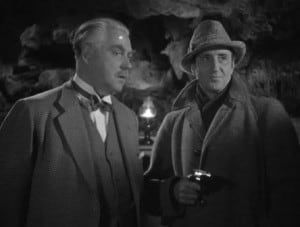 On the other hand, in The House of Fear the plentiful clues are somewhat offset by the repetitive sameness of the deaths and Holmes’ somewhat sluggish arrival at a solution, not until very near the end.
On the other hand, in The House of Fear the plentiful clues are somewhat offset by the repetitive sameness of the deaths and Holmes’ somewhat sluggish arrival at a solution, not until very near the end.
The House of Fear is based on Doyle’s “The Five Orange Pips,” the fifth tale in the first collection of stories, The Adventures of SherlockHolmes, published in 1892, about the vengeance the Ku Klux Klan serves on a former planter in Florida who “fought in Jackson’s army and afterwards under Hood” during the Civil War. In the film, little of the original story is retained, except for the orange pips as harbingers of death.
The film is more closely related to Agatha Christie’s Ten Little Indians, where murder victims pile up without defense or solution. In that mystery, also known as And Then There Were None, there is no detective; in fact, the murderer, acting equally frightened and perplexed by the deaths, is among the guests at the hotel. Only difference, in The House of Fear Sherlock Holmes is on the job after the first two murders, which, nevertheless, mount to five more. And what was that about a “two-clues-behind companion”? Watson is the one who solves the mystery! . . . And there is, by the way, only one actual murder!
 In the opening of the original story, during one of those frequent occasions when “the wind had screamed and the rain had beaten against the windows,” John Openshaw tells Holmes that his frightened uncle has received an envelope containing five dried orange pips. In the film, an insurance investigator (Gavin Muir) explains to Holmes and Watson his suspicions about two deaths in Scotland at a cliffside manor named Drearcliff House.
In the opening of the original story, during one of those frequent occasions when “the wind had screamed and the rain had beaten against the windows,” John Openshaw tells Holmes that his frightened uncle has received an envelope containing five dried orange pips. In the film, an insurance investigator (Gavin Muir) explains to Holmes and Watson his suspicions about two deaths in Scotland at a cliffside manor named Drearcliff House.
It seems that a group of seven elderly men, with no obligations or living relatives and calling themselves the Good Comrades, have moved in together, taking out insurance policies, with each other as beneficiaries. Shown in a flashback, the housekeeper, Mrs. Monteith (Sally Shepherd), brings to the men at dinner an envelope addressed to Ralph King (Dick Alexander). Out of the envelope falls six orange pips, which prompts laughter from everyone. The next night, King’s car plummets from a cliff and explodes. When a second envelope is delivered to Stanley Raeburn (Cyril Delevanti), “This time you may be sure,” the insurance man relates, “there was no laughter.” Ten days later, Raeburn’s battered body is recovered from the sea.
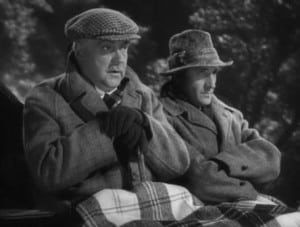 When Holmes learns that Simon Merrivale (Paul Cavanagh) is one of the Good Comrades, he accepts the case. After a train journey on the famous “Flying Scotsman,” Holmes and Watson take a horse and trap to a village near Drearcliff. Holmes explains that Merrivale was once a famous London surgeon, acquitted of the murder of his young bride. As for the two current deaths, Holmes muses that he’s not saying Merrivale is responsible, only that he might be. Then he adds, “Murder is an insidious thing. Once a man has dipped his fingers in blood, sooner or later he’ll feel the urge to kill again.” The lines, as best I’ve been able to research, aren’t by Doyle, though they sound, certainly, Holmesian; they do, however, have a touch of Leviticus 14:16.
When Holmes learns that Simon Merrivale (Paul Cavanagh) is one of the Good Comrades, he accepts the case. After a train journey on the famous “Flying Scotsman,” Holmes and Watson take a horse and trap to a village near Drearcliff. Holmes explains that Merrivale was once a famous London surgeon, acquitted of the murder of his young bride. As for the two current deaths, Holmes muses that he’s not saying Merrivale is responsible, only that he might be. Then he adds, “Murder is an insidious thing. Once a man has dipped his fingers in blood, sooner or later he’ll feel the urge to kill again.” The lines, as best I’ve been able to research, aren’t by Doyle, though they sound, certainly, Holmesian; they do, however, have a touch of Leviticus 14:16.
At the inn where Holmes and Watson are staying, they learn of the local legend that “no man goes whole to his grave,” and Nigel Bruce displays some of his humor, thanks to a passing funeral cortege.
“Cut down in the flower of his manhood,” observes Alex MacGregor (David Clyde), the local tobacconist.
“What a pity,” Watson says. “Young fellow, eh?”
“Just seventy-two.”
“Seventy-two?! ‘Flower of his manhood’? Trying to be funny?”
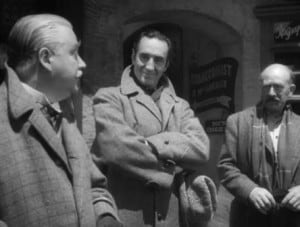 Holmes embarrassingly directs his friend inside the inn, Watson muttering under his breath.
Holmes embarrassingly directs his friend inside the inn, Watson muttering under his breath.
But wait! There’s been another death, and Holmes and Watson rush to Drearcliff. The bubbly Bruce Alastair (Aubrey Mather) introduces the two men to his three fellow Comrades. Another member, Guy Davies (Wilson Benge), has been, as it were, burnt to a crisp in the household furnace, and, again, like his two predecessors, physically unidentifiable, except by his cuff links. When Merrivale suggests Alastair should have removed the body from the cellar, the little rotund man replies, “No, Merrivale, you found it. It’s your body.”
Holmes and Watson decide to stay at Drearcliff. Speaking another Holmesian line apparently not found in Doyle, Holmes remarks, “At the moment, I suspect no one and everyone.” (The “great” Inspector Clouseau speaks a similar line in A Shot in the Dark.)
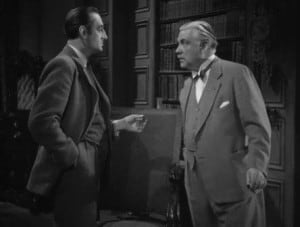 After dinner, the pipe-smoking Captain Simpson (Harry Cording) is frightened to see a needle in a chair, and Holmes discovers that there is, indeed, one—and poisoned. At dinner, Simpson is frightened again, now to smell bitter almonds in his wine. Afterward, when Watson is standing closer to the chair than Simpson had, Holmes asks him if he can see a needle. No, Watson replies. There is one, Holmes says—he put it there—and suggests that the earlier needle was planted, but that Simpson’s reaction to the bitter almond smell in his wine was genuine horror. Holmes had planted that, too—no deadly poison, simply bitter almonds.
After dinner, the pipe-smoking Captain Simpson (Harry Cording) is frightened to see a needle in a chair, and Holmes discovers that there is, indeed, one—and poisoned. At dinner, Simpson is frightened again, now to smell bitter almonds in his wine. Afterward, when Watson is standing closer to the chair than Simpson had, Holmes asks him if he can see a needle. No, Watson replies. There is one, Holmes says—he put it there—and suggests that the earlier needle was planted, but that Simpson’s reaction to the bitter almond smell in his wine was genuine horror. Holmes had planted that, too—no deadly poison, simply bitter almonds.
One purpose in relating all this, is that these proceedings inspire one of Holmes’ intellectual ponderings so familiar in these films:
“I don’t know, Watson. This is a most unique case. Instead of too few, we have too many clues and too many suspects. The main pattern of the puzzle seems to be forming, but the pieces don’t fit in.” (Remember Hercule Poirot’s sing-song comment, “There are too many c-l-u-e-s in this r-o-o-m,” in the 1974 Murder on the Orient Express?) . . .
“Muddy water, eh, Holmes?”
“Too muddy. As if someone were constantly stirring them up.”
“Why should they stir them up?”
“To confuse me. There’s intelligence behind this business, Watson—cold, calculating, ruthless intelligence.”
Another death, again preceded by the arrival of Mrs. Monteith with an envelope of an ever-decreasing number of orange pips—one for each of the surviving Comrades. Alan Cosgrove (Holmes Herbert) is blown to bits by dynamite stored in a shed, his only identification a finger ring.
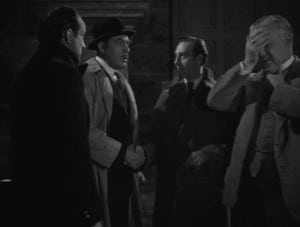 This compels the arrival of Inspector Lestrade (Dennis Hoey, the fifth of his six appearances in the Universal series). It’s not a matter of the arrival of the cavalry in the nick of time—certainly not with Holmes on the scene—for Lestrade, as usual, is of little help. He merely stumbles about, though in this outing he proves the equal of Watson in providing comic relief. Hoey would pretty much resume the Lestrade character in Frankenstein Meets the Wolf Man, only now as Inspector Owen.
This compels the arrival of Inspector Lestrade (Dennis Hoey, the fifth of his six appearances in the Universal series). It’s not a matter of the arrival of the cavalry in the nick of time—certainly not with Holmes on the scene—for Lestrade, as usual, is of little help. He merely stumbles about, though in this outing he proves the equal of Watson in providing comic relief. Hoey would pretty much resume the Lestrade character in Frankenstein Meets the Wolf Man, only now as Inspector Owen.
Soon after, Simpson, having disappeared, is found on the beach, deprived of head, arms and legs, severed, as a policeman reports, with the skill of a surgeon’s scalpel. He’s identified only by the tattoo on this chest of a fully rigged ship, which Holmes had admired earlier.
Two members remain, Merrivale and old genial Alastair. Looks like it could be Merrivale, after all. No one could suspect little old Alastair, though Watson had earlier observed that he was “too good to be true,” yet Watson had also proposed any number of other suspects.
But just when things seem to be working toward a solution, there’s a “bonus” death, one not related, Holmes explains, to the Drearcliff murders. After sending a note to Lestrade, the tobacconist is found shot dead. In Holmes’ appeal to the local fishermen for help, one (Alec Craig) steps forward. He had delivered the note and adds that MacGregor had said he didn’t believe in ghosts. Turns out, MacGregor had seen one of the dead men walking the beach late at night.
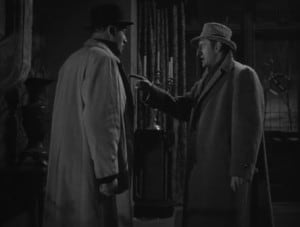 When Holmes and Watson return to Drearcliff, they learn that Merrivale has been crushed to death by a falling rock—unrecognizable, of course—and Lestrade, in his ever-sure logic, has arrested old Alastair, the lone survivor of the Good Comrades. Who else could it be? . . .
When Holmes and Watson return to Drearcliff, they learn that Merrivale has been crushed to death by a falling rock—unrecognizable, of course—and Lestrade, in his ever-sure logic, has arrested old Alastair, the lone survivor of the Good Comrades. Who else could it be? . . .
But now Watson has disappeared!
The tobacconist having seen ghosts on the beach inspires Holmes toward a solution. Added to that, in pacing off the interior of the main room, he finds it “obviously several feet less” than the twenty-eight-foot outside wall, a clue lifted from “The Norwood Builder,” the third of the collection of adventures, The Return of Sherlock Holmes, published in 1905. There must be a secret passage, Holmes reasons. With Lestrade in tow, he finds it almost immediately—no, not behind the bookcase, but accessed through the fireplace.
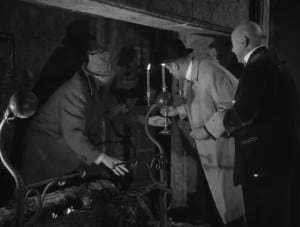 The two men find a stairwell and are descending in the gloom when Lestrade stumbles. “Quiet!” Holmes says, “they’ll hear us.” “Who’s ‘they’?” Lestrade asks. In a large cave, used by smugglers in the eighteenth century, they find the six Good Comrades—all alive. And Watson.
The two men find a stairwell and are descending in the gloom when Lestrade stumbles. “Quiet!” Holmes says, “they’ll hear us.” “Who’s ‘they’?” Lestrade asks. In a large cave, used by smugglers in the eighteenth century, they find the six Good Comrades—all alive. And Watson.
The real solver of the mystery—at least the first to sense the solution—is Watson himself, for that is why he was kidnapped in the cave: he had commented, and been overheard, that Captain Simpson’s smoking tobacco had disappeared from the humidor, and why would a dead man need his tobacco?
It was all a scheme for the insurance money, Holmes explains, with Alastair being the dupe. And the bodies? They were the recent dead from the local cemetery, mutilated beyond recognition. Holmes had further deduced that the tattoo on Simpson’s supposed body was recently applied, though he didn’t, apparently, notice that some of the corpses were—well, no longer “fresh.” And MacGregor had been shot by Simpson because he had seen too much. Not explained (if explainable) was how the six Comrades expected to collect on their insurance: being “dead,” all the money would have gone to the surviving beneficiaries, on down the line, and as the sole survivor would have been Alastair, even he, as the set-up murderer, could not have collected.
 The end of the earlier Universal films had often closed with a patriotic homily in which Holmes quotes Winston Churchill, Shakespeare about “this blessed plot, this earth, this realm, this England” or even Doyle himself about the “cold and bitter” east wind that is coming. As it would be later in Dressed to Kill, in The House of Fear the message is personal, a tribute to Holmes and Watson themselves:
The end of the earlier Universal films had often closed with a patriotic homily in which Holmes quotes Winston Churchill, Shakespeare about “this blessed plot, this earth, this realm, this England” or even Doyle himself about the “cold and bitter” east wind that is coming. As it would be later in Dressed to Kill, in The House of Fear the message is personal, a tribute to Holmes and Watson themselves:
“It was your timely warning,” Holmes says to Alastair, “when you drew our attention to the empty tobacco jar and saved the life of my dear friend and colleague Dr. John H. Watson——”
“Very nice of you, old boy,” Watson murmurs, nodding his head shyly.
“——thereby enabling us to continue our long and happy association together.”
As for the next film in the series, Lestrade provides a clue, perhaps intentionally written into the script, perhaps not. He mentions that the murderer in this Good Comrades case reminds him of his capture of the notorious Professor Moriarty, to which Watson admonishes him for his undue credit. This “Napoleon of Crime,” as Holmes called him, would appear in the next film, The Woman in Green, played by one of filmdom’s supreme villains, Henry Daniell. In two earlier films, Moriarty had been played by George Zucco and Lionel Atwill.
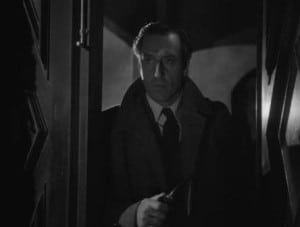 It has been written that Basil Rathbone was tiring of his role and resenting his typecasting as, and over-association with, Sherlock Holmes. The House of Fear was his tenth Holmes film—fourteen, it would prove, in eight years—and the weekly radio broadcasts had already been on the air for six years. People on the street would greet Rathbone as “Hello, Sherlock” or as “Mr. Holmes.” If he shows a little fatigue in this film, it’s possibly because he was bored with a script that had so many similar “murders” and ones that remained unsolved for so long. This fault must lie with a new screenwriter for the series, the first and only contribution by Roy Chanslor. Rathbone’s boredom with Sherlock Holmes, however, would become more obvious in the later films.
It has been written that Basil Rathbone was tiring of his role and resenting his typecasting as, and over-association with, Sherlock Holmes. The House of Fear was his tenth Holmes film—fourteen, it would prove, in eight years—and the weekly radio broadcasts had already been on the air for six years. People on the street would greet Rathbone as “Hello, Sherlock” or as “Mr. Holmes.” If he shows a little fatigue in this film, it’s possibly because he was bored with a script that had so many similar “murders” and ones that remained unsolved for so long. This fault must lie with a new screenwriter for the series, the first and only contribution by Roy Chanslor. Rathbone’s boredom with Sherlock Holmes, however, would become more obvious in the later films.
Observant viewers will recognize the Drearcliff interiors and exteriors from the sets. for Hulstone Towers in Sherlock Holmes Faces Death—that elaborately cluttered living room, the suits of armor and the checkerboard floor that was key, in the earlier film, to another secret passage that led to a crypt. The scenes at the inn and graveyard are the familiar Universal sets used in the Frankenstein and Wolf Man movies.
Paul Cavanagh, Holmes Herbert, Harry Cording, Gavin Muir and Dennis Hoey are among the recurring actors in this Holmes series, all having appeared in at least three of the films. There were other frequent repertoire players who were absent in The House of Fear—Olaf Hytten, Harold De Becker, Frederic Worlock, Hillary Brooke, Ian Wolfe and of course Mary Gordon, who played Holmes’ landlady Mrs. Hudson in ten of the films.
In The House of Fear, composer Paul Sawtell wrote what sounds like new music, rather than recycle what had already been written by himself, Frank Skinner, Hans J. Salter and others, cues used repeatedly for suspense, skulking, action and the sundry other atmospheric needs of mysteries. For both 20th Century-Fox films Cyril J. Mockridge wrote the music, perhaps of better quality, but unfortunately sparse.
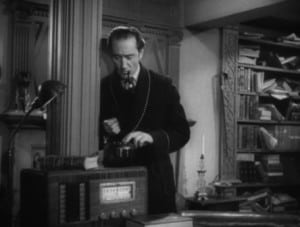 All but one of the Universal films (Sherlock Holmes and the Voice of Terror) were directed by Roy William Neill, born in Britain but living in America as a U.S. citizen. Something of an authority on Sherlock Holmes, he was most concerned with detail and accuracy in these films. In the long opening scene of The House of Fear, at number 221B Baker Street, Holmes, pipe in hand, ambles about the room looking for something—as the observant viewer will sense—until he finally finds it, his tobacco in the famous Persian slipper.
All but one of the Universal films (Sherlock Holmes and the Voice of Terror) were directed by Roy William Neill, born in Britain but living in America as a U.S. citizen. Something of an authority on Sherlock Holmes, he was most concerned with detail and accuracy in these films. In the long opening scene of The House of Fear, at number 221B Baker Street, Holmes, pipe in hand, ambles about the room looking for something—as the observant viewer will sense—until he finally finds it, his tobacco in the famous Persian slipper.
Despite this technical concern, Neill allowed the 1940’s setting of the films and, in the first two of those he directed, permitted Rathbone’s ghastly coiffure, his hair swept forward around his temples. Although the director, his control was obviously limited. Neill died in 1946 of a heart attack, age 59, soon after finishing Dressed to Kill and one other film, a film noir Black Angel.
At the end of the original “Five Orange Pips” adventure, Holmes had mailed an envelope containing some of those dreadful orange pips to the three murderers of John Openshaw, for he, too, had been killed along with his uncle. The envelope was addressed to Savannah, Georgia, to be waiting when the murderers’ ship, the “Lone Star,” arrived. Further, to the Savannah police Holmes sent a cable, stating that the three men should be arrested for murder charges in England. Justice came prematurely, though. The “Lone Star” was lost at sea during its Atlantic voyage.
A lot of people complain about Nigel Bruce’s depiction of Watson, but I for one thoroughly enjoyed his part in all of these Holmes pictures. In The House of Fear Holmes really makes sport of Watson in a number of scenes….but what great lines Watson gets to sputter in return! This film – and Sherlock Holmes Faces Death – are my dad’s two favorite Sherlock Holmes pictures. Like you, it’s mostly because of the atmosphere, but they do boast great storylines too.
Rathbone ultimately freed himself from the Sherlock Holmes role not long after this film, but at the cost of a thriving career. Andy Demsky’s “Leaving Baker Street” piece (http://www.basilrathbone.net/potpourri/bakerst.htm) is sad reading. Rathbone went from doing 5 or 6 pictures a year to 1 every couple of years, with some TV appearances thrown in.
Especially poignant is a quote from Michael Druxman’s biography Basil Rathbone: His Life and His Films: “A group of children was following the actor on the street one day, calling out for an autograph — calling out the name ‘Sherlock Holmes.’ Rathbone whirled around and demanded that they say his real name. ‘Sherlock Holmes,’ came the reply. He refused to give them an autograph until they could produce his real name — which they could not do.”
Although THE SCARLET CLAW is my favorite of Universal’s “modern” Holmes movies, I think this one is pretty good, too. Overall, I think the Rathbone-Bruce films are pretty entertaining, except for PURSUIT TO ALGIERS and DRESSED TO KILL.